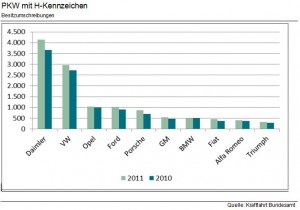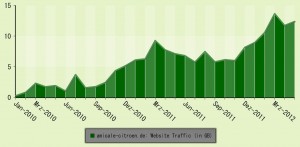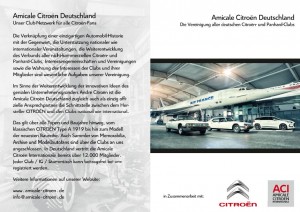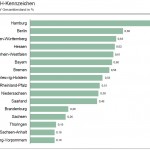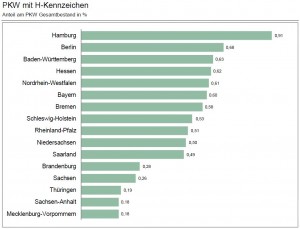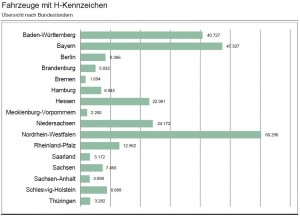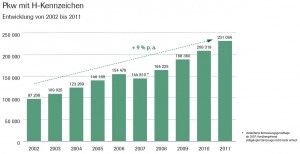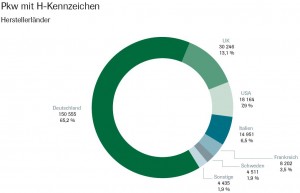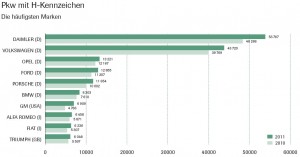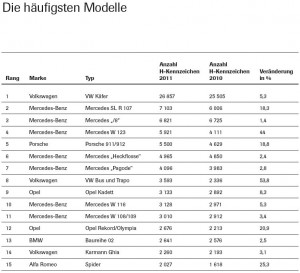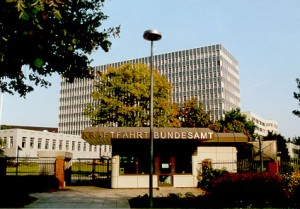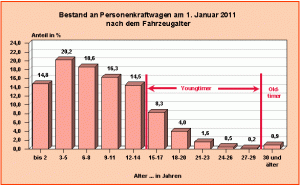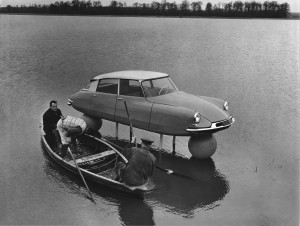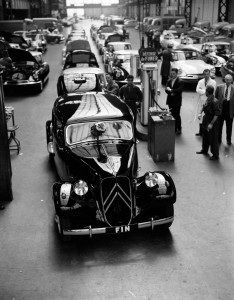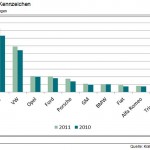
Über 16.000 Besitzumschreibungen von Oldtimern in 2011
Die Anzahl der Besitzumschreibungen von Fahrzeugen mit H-Kennzeichen hat 2011 im Vergleich zu 2010 um 11,8 Prozent zugenommen. Trotzdem blieb der Anteil der Oldtimer am gesamten Gebrauchtwagenmarkt mit 0,2 Prozent nahezu unverändert gering. Das hat eine Auswertung des Kraftfahrt-Bundesamtes gezeigt, die zum zweiten Mal im Auftrag des Verbands der Automobilindustrie (VDA) durchgeführt wurde. Aus der Studie geht hervor, dass 2011 in Deutschland 16.120 registrierte PKW mit H-Kennzeichen verkauft bzw. an einen neuen Besitzer überschrieben wurden. Der gesamte PKW-Bestand in Deutschland von rund 43 Millionen wies 2011 fast 6,8 Millionen so genannte Besitzumschreibungen auf, was einer Zunahme gegenüber 2010 von 4,8 Prozent entspricht. Umschreibungen beim Kraftfahrt-Bundesamt erfolgen dann, wenn ein Gebrauchtwagen, meistens durch Verkauf, einen neuen Besitzer erhält.
Nach wie vor bleibt der Besitzwechsel bei Oldtimern mit 7 Prozent vom Gesamtbestand an PKW mit H-Kennzeichen weit unter dem Durchschnitt. Der gesamte PKW-Bestand wies für den gleichen Zeitraum eine Umschreibungsquote von 15,9 Prozent auf. Das ist ein deutliches Zeichen, dass Oldtimerbesitzer eine wesentliche stärkere Bindung zu Ihren Schätzen haben.
Bei den Besitzumschreibungen von Fahrzeugen mit H-Kennzeichen erscheinen Fahrzeuge von Mercedes-Benz am häufigsten. Immerhin jedes vierte Fahrzeug (25,7 Prozent) der gehandelten Oldtimer ist ein Wagen mit dem Stern, ein noch höherer Wert als der schon hohe Anteil am Oldtimerbestand (23,3 Prozent). Es folgen die Fahrzeuge von Volkswagen (18,3 Prozent) vor Opel und Ford (6,5 und 6,3 Prozent). Den stärksten Zuwachs bei den Besitzumschreibungen gegenüber dem Vorjahr verzeichnen die Sportwagen von Porsche mit einem Plus von 23 Prozent.
H-Kennzeichen sind für Oldtimerfahrzeuge vorgesehen, die mindestens 30 Jahre alt sind. Im Jahr 2011 waren in Deutschland 231.064 Pkw mit H-Kennzeichen gemeldet. Voraussetzung für ein H-Kennzeichen ist neben dem Mindestfahrzeugalter ein guter Pflege- und Erhaltungszustand. Außerdem muss das Fahrzeug seit der Auslieferung weitgehend unverändert sein. Für Fahrzeuge mit H-Kennzeichen fällt ein einheitlicher Kfz-Steuersatz von 191,73 Euro an. Darüber hinaus haben die Fahrzeuge freie Zufahrt in den Umweltzonen. Nur ein Teil der Autos, die älter als 30 Jahre sind, tragen ein H-Kennzeichen. Ihr Anteil beläuft sich auf knapp 60 Prozent. Das H-Kennzeichen ist das sichtbare Zeichen aller echten Oldtimer, die von ihren Besitzern über viele Jahre hinweg liebevoll und oft mit hohem Aufwand gepflegt werden, um ein Stück automobilen Kulturguts zu erhalten.
Quelle: VDA
—–
More than 16.000 classic cars change ownership in 2011 in Germany
The number of title transfers of vehicles with historic number plate (“H-plate”, type “..-… H”) in 2011 has increased compared to 2010 by 11.8 percent. Nevertheless, the proportion of the total vintage car market remained low and almost unchanged at 0.2 per cent. That the result of an evaluation of the Federal Motor Vehicle Office (“Kraftfahrtbundesamt”, KBA), which was conducted for the second time on behalf of the Association of the Automotive Industry (VDA). The study shows that in Germany in 2011 16,120 cars registered with H-plates were sold or overwritten to a new owner. The total number of cars in Germany of around 43 million in 2011 had lead to owner changes of nearly 6.8 million, an increase over 2010 of 4.8 percent.
The Federal Motor Vehicle Office registers this procedure when a car, mostly by sales, gets a new owner.
As before, the change of ownership of classic cars remains well below average, as just 7 percent of the total stock of cars with H-plates change ownership. The total number of ownership changes for all cars for the same period was at a level of 15.9 percent. This is a clear sign that classic car owners have a stronger bond with their vintage vehicles.
From a statistical perspective, the change of ownership of vehicles with H-plates is led by Mercedes-Benz vehicle. After all, every fourth vehicle (25.7 percent) of the traded vintage is a car built by the Stuttgart-based brand, an even better value than the already high proportion of Mercedes vehicles of all German-registered vintage cars (23.3 percent). Followed by vehicles of Volkswagen (18.3 percent) before Opel and Ford (6.5 and 6.3 percent). The strongest growth was in the title transfers from the previous year, led by sports cars from Porsche which reported an increase of 23 percent.
H-plates for classic cars are provided for those vehicles which are at least 30 years old. In 2011, 231.064 cars in Germany with H-plates were registered. Condition for H-plate next to the minimum age of the vehicle is a good care and condition. In addition, the vehicle must be largely unchanged since its delivery. For vehicles with H-plates one single motor vehicle tax rate as high as 191.73 Euro has to be paid, regardless of engine power or cubic size. In addition, the vehicles will have free access to environmental zones. Only part of the cars that are over 30 years old have been assigned a H-plate. Their share amounts to almost 60 percent. The H-plate is the visible sign of all true classic that are held by their owners for many years and often lovingly maintained with great effort to preserve a piece of automotive heritage.
Translation: Amicale Citroën
—–
Plus de 16.000 de changements de la propriété pour les voitures classiques en 2011
Le nombre de transferts de titres de véhicules avec “plaque H” (plaque historique, type “…-… H”) en 2011 a augmenté par rapport à 2010 de 11,8%. Néanmoins, la proportion du marché de voitures anciennes total est resté pratiquement basse et inchangé à 0,2%. C’est le resultat d’une évaluation de l’Office fédéral des véhicules automobiles (“Kraftfahrtbundesamt”, KBA), qui a été menée pour la deuxième fois au nom de l’Association de l’Industrie Automobile en RFA (VDA). L’étude montre qu’en 2011, ont été vendus en Allemagne 16.120 voitures immatriculées avec H-plaques ou écrasés à un nouveau propriétaire. Le nombre total de voitures en Allemagne c’est d’environ 43 millions en 2011, et à près de 6,8 millions ont fait un changement de propriétaire, soit une augmentation par rapport à 2010 de 4,8 pour cent.
Comme précédemment, le changement de propriétaire reste avec des voitures anciennes avec 7 pour cent dessous de la moyenne du stock total de véhicules avec des plaques H. Pour toute les voitures, pas seulement les anciennes, le nombre total des changements de la propriété pour la même période est 15,9%. Il s’agit d’un signe clair que les propriétaires de voitures anciennes ont un lien plus fort avec leurs véhicules.
Le no. 1 dans le changement de propriétaire de véhicules équipés avec des H-plaques sont les véhicules de Mercedes-Benz. Après tout, chaque quatrième véhicule (25,7 pour cent) de la vendange en bourse est une voiture de Stuttgart. Voici les véhicules de la marque Volkswagen (18,3 pour cent) avant Opel et Ford (6,5 et 6,3 pour cent). La plus forte croissance a été dans les transferts de titres de l’année précédente, la voiture de sport de Porsche qui ont signalé une augmentation de 23 pour cent.
H-plaques pour les voitures classiques sont prévus pour les voitures qui sont au moins 30 ans. En 2011, 231.064 voitures en Allemagne avec H-plaques ont été registrés. Condition pour H-plaque à côté de l’âge minimum du véhicule est un bon soin et etat. En outre, le véhicule doit être en grande partie inchangée depuis la livraison. Pour les véhicules avec plaques H la taux est fixe de €191,73. En outre, les véhicules auront libre accès aux zones environnementales. Seule une partie des voitures qui ont plus de 30 ans, vêtu d’un des H-plaques. Leur part s’élève à près de 60 pour cent. Le plaque H est le signe visible de tous vrai classique qui par leurs propriétaires pendant de nombreuses années et souvent amoureusement entretenu avec beaucoup d’effort pour obtenir un morceau du patrimoine automobile.
Traduction: Amicale Citroën
